5 Causes of Denting on Your Gecko Eggs [and 4 Solutions]
Sure, the breeding season can be incredibly amazing and exciting for most people with lovely gecko babies but it’s not always a fun and easy time to look after their eggs. Especially when you find that they have dents!
The causes that trigger denting in gecko eggs are: dehydration, poor calcification, frequent handling, unviability, and being close to hatch. Problematic dents can easily be resolved and prevented unless it is due to unviability.
Read to find out what dented gecko eggs look like, why this happens, and how to deal with them!
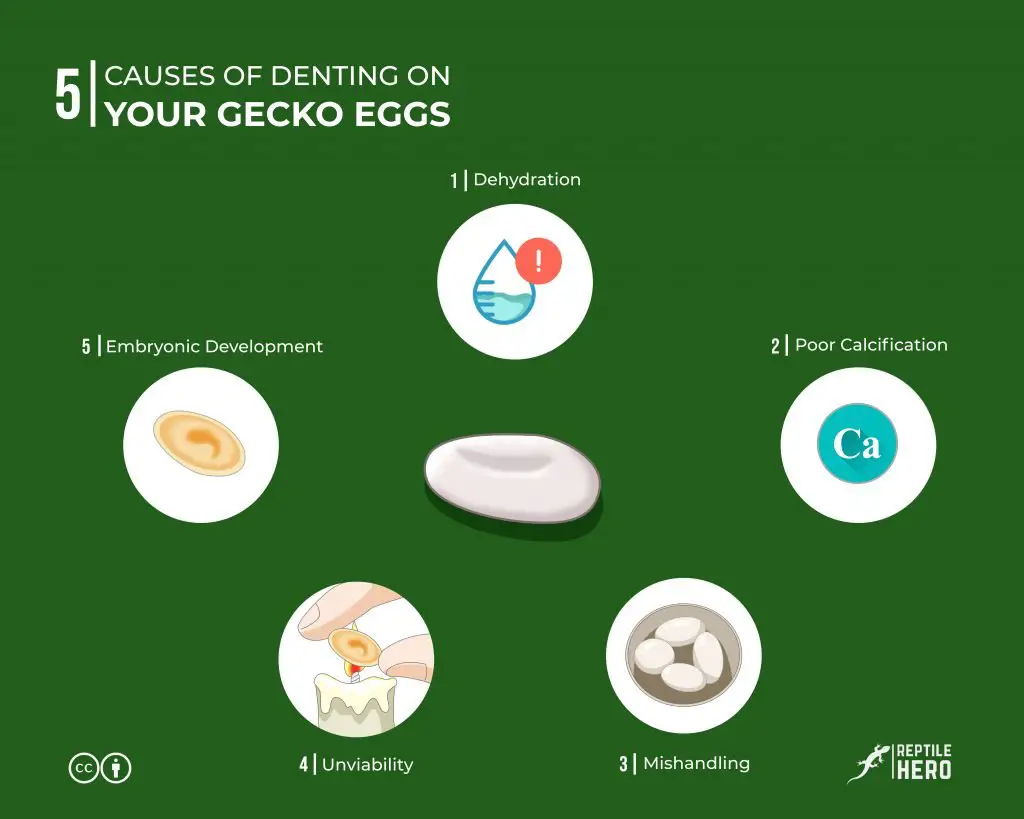
Dented Gecko Eggs: The What & Whys
As a newbie gecko keeper (many years ago), when I first found out that their eggs could cave in two questions immediately popped into my mind: what and why? Over the years, I found out that there is not a single answer to both of my queries. So to help out prospective and beginner gecko parents, I decided to consolidate my years of experience with dented gecko eggs into one article.
What do Dented Gecko Eggs Look Like?
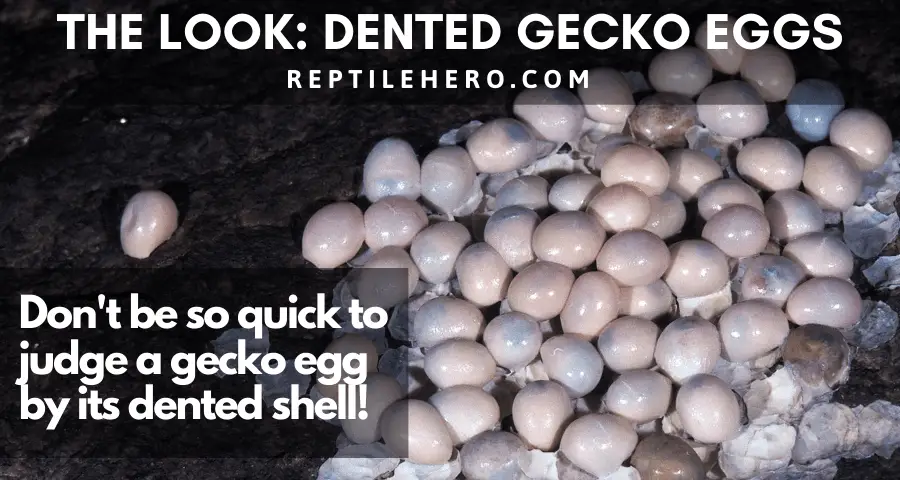
The appearance of denting in gecko eggs varies in location, number, size, depth, texture, and color. The exact factors causing the distinct superficial variations in dented gecko eggs are unknown.
Most people – myself included – usually look for only one answer to explain why or how things are the way they are. But many things in life can actually be explained in several ways according to specific circumstances and different factors. The same is true when it comes to the appearance of dented gecko eggs.
Gecko eggs come in a variety of sizes, shapes, and shades. Some gecko eggs are tiny while others are considered big for their size. They can be pretty round or elongated. Like paint, they also come in a wide range of colors – from chalky white, pale yellow, and muddy brown, to grossly green, the list can go on and on.
The way the gecko eggs dent is also quite diverse. It could form at the bottom, on top, or along the sides. A gecko egg could have one dent or multiple. The dent may be small or big, shallow or deep. The indentations could be relatively smooth to the touch. But it could also feel like old cracked leather with wrinkles forming in the depression. Discoloration could be more pronounced in the sunken areas of the eggshell as well.
If you’ve yet to see a dented gecko egg, here’s a short time-lapse video on how the external appearance changes as time pass:
I’m still not sure why there is no physical uniformity in terms of denting for gecko eggs. When I asked more experienced breeders and keepers, it was clear that they weren’t sure either. Moreover, it’s quite honestly just difficult for us regular folks to pinpoint which factors cause which variations because scientists have yet to study this and as a result, we have no conclusive data on the topic.
Nevertheless, two factors emerged to be very likely causes that affect the physical features of dented gecko eggs: their mother’s diet during the breeding season and the substrate they are laid in. Again, this is just pure conjecture on my part, so take it with a grain of salt.
5 Reasons Why Your Gecko Eggs Are Dented
Now that you know what dented gecko eggs could possibly look like, we can explore the 5 most common reasons why gecko eggs become dented.
#1 – Dehydration
In most cases of denting in gecko eggs, dehydration is the cause. Dehydrated gecko eggs start forming dents on the surface due to a lack of humidity and/or a moist substrate.
Normally, people would think that oviparous (egg-laying) animals like geckos would produce hard-shelled eggs to make sure that their offspring will survive through incubation. But if you’ve ever held a gecko egg in the palm of your hand, you know that this isn’t the case.
I was actually also surprised by how squishy it was. It felt like a stale marshmallow that still had a little bounce to it when lightly pressed. So don’t go poking or gripping onto it because it’s much more delicate than you’re probably imagining.
More importantly, one study [1] has shown that geckos produce eggs with shells that have a lot less proline compared to lizards and snakes. Proline, one of the 17 major amino acids found in eggshells, is important in terms of weathering incubation environments that are extremely dry.
Once the gecko eggs are laid, they will constantly interact with their surroundings to maintain a healthy level of water balance using their considerably porous and flexible shells. They can absorb moisture from the substrate and the air around them. When they can no longer harvest water from their environment, the developing embryo will start using up the water reserves from the egg’s albumen [2].
#2 – Poor Calcification
What exactly leads to the under calcification of eggshells? Well, I can name two reasons in particular.
First, we know that female geckos require a lot of calcium to produce their eggs. However, their diets – regardless of whether they are insectivores or frugivores – are usually deficient in this essential nutrient. So if they’re not given proper supplementation, they will produce inadequately calcified eggs in spite of spending much of their already very limited calcium reserves.
So please don’t ever try to breed your little ladies if they’re already suffering from metabolic bone disease. The consequences can be fatal. Always put your gecko’s health first. Only consider breeding healthy female adults.
Second, first-time breeders are known to produce wonky and improperly calcified eggs due to a lack of experience. In such cases, even if they have been given additional calcium, they may still produce under-calcified gecko eggs.
Either way, eggs that are not calcified enough become weaker than normal and more prone to both drying up and caving in due to how thin their shells are. Their supposed protective layer is pretty much rendered useless due to its lack of structural integrity when not properly incubated or handled.
Lack of calcium reserves, or the improper distribution of it during the egg production of gravid geckos, causes the shells to become much weaker and more permeable. As a result, they are prone to developing dents.
#3 – Mishandling
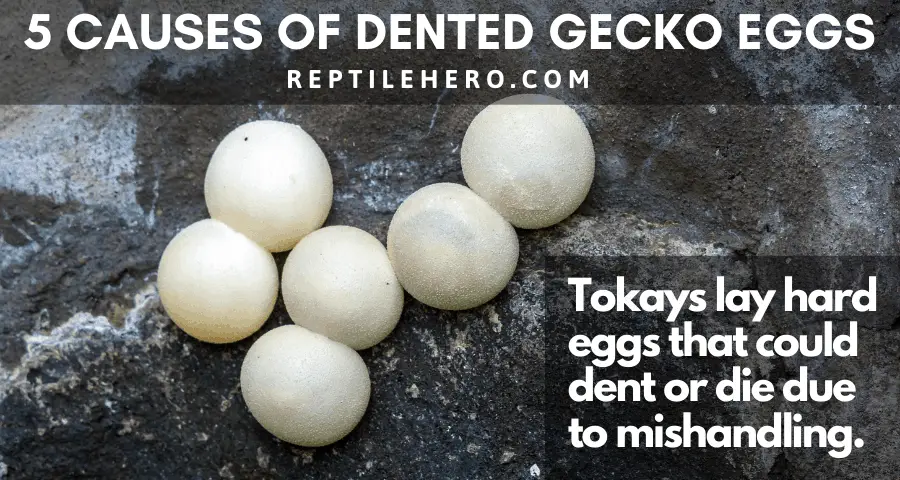
The majority of gecko species kept as pets like leopard and crested geckos produce eggs that are surprisingly quite hardy despite having softer shells compared to other egg-producing animals like birds. Nevertheless, these soft-shelled gecko eggs are quite incredibly delicate since they are pliable. This may be why most experts advise against regular handling during incubation.
When handled frequently, gecko eggs are more likely to dry up faster when exposed to air that is not adequately humid. Their shell may also sink in even when only applying moderate amounts of force in holding them.
Some of my friends have dented a few clutches after taking them out of their incubators for far too long and far too often. I’ve also chatted with a few acquaintances who dented a few eggs from accidentally bumping them into each other while moving their containers, accidentally dropping them while inspecting, and holding them too tightly while candling.
Keep in mind, certain gecko eggs should never be moved at all. I’m talking about the more hard-shelled eggs that species like Tokays lay [3]. Although they’re more calcified than most gecko eggs, they’re still pretty fragile. So if you force them off the branch, bark, glass, or whatever surface they were laid on, I’m fairly sure they still dent. As a matter of fact, such damage could be deadly for these eggs.
I’ve also heard of some people claiming that we produce acid oils from the palms of our hands which could clog the microscopic pores on an eggshell and hinder its normal exchange of water and air with its surroundings. Although it’s definitely an interesting theory, I’ve yet to read anything that definitively proves that this indeed happens.
#4 – Unviability
Partly due to the reasons that I have already mentioned, some keepers (whether they’re breeding their adorable geckos annually or only rarely) refuse to handle their gecko eggs at all. That is, of course, with only the exception of transferring soft-shelled eggs produced by most geckos into their incubation containers.
If you’re familiar with candling, which is what most people do to check for viability, you know that it’s definitely hard to check for the red donut or the “cheerio of life” without personally holding the eggs against a good light source. It’s not impossible to candle gecko eggs without picking them up from their incubators but it’s definitely hard.
Considering that, it’s understandable that people who choose to not check for their gecko eggs’ viability get a few ones denting in during the course of incubation even when kept in a highly humid container because they were never fertile, to begin with.
Fertile gecko eggs could also start having dents when the embryo inside has failed or died. Several different reasons could be responsible for the death of a developing gecko embryo, though I have not really come across a study on it yet. But I think that genetic issues and deformities are likely causes.
Despite correct incubation set-ups, some gecko eggs will dent in and then even deflate due to unviability. Gecko eggs that are not viable are either unfertilized eggs or ones that have not survived during embryonic development.
So having dented gecko eggs doesn’t necessarily make you a bad keeper. There are just some things that you can’t directly control even if you use the best incubator available in the market and regularly check on your eggs.
#5 – Embryonic Development
Okay, I know I’ve painted quite a bleak picture of dented gecko eggs in the past few sections. Don’t worry though! Having dents in your gecko’s eggs isn’t always a bad thing. It could actually also be a sign that you’re going to meet cute and spirited little baby geckos soon.
A gecko egg that is nearing the completion of its embryonic development and is set to hatch will gradually and steadily cave in as the growing baby gecko continues to absorb water and nutrient reserves from the albumen. It will also draw in as much calcium and many other minerals from the eggshell [4]. Typically, good eggs start denting 1 to 7 days before hatching depending on the temperature and humidity they are incubated in.
Healthy and fertile gecko eggs will start denting in at least 1 day before hatching. Such deflation in a viable egg is due to the baby gecko absorbing the leftover water from the albumen and calcium from the shell.
Yes, dented gecko eggs do hatch.
Earlier in the article, I’ve already mentioned that some geckos produce relatively more calcified shells compared to most species. Hard-shelled eggs of certain gecko species like Tokays are made to contain all the water they need while developing and not lose much of it even when exposed to dry air up in the trees.
Usually, they only dent when they’re about to hatch because their thicker-than-normal shells have already lost some calcium and minerals. Though this thinning of their calcified shells could allow them to be more able to absorb water from their environment, they aren’t buried in a moist substrate like soft-shelled eggs so they have pretty much no water to absorb from their surroundings.
Just check this video out:
In the first minute or so, you can clearly see that the other egg beside the newly hatched Tokay is dented. It’s probably due to hatch in a day or two – maybe even in just a few hours if it’s the clutch mate of the new hatchling. You might’ve also noticed that these precious little babies are a lot drier than those of leos and cresties once they’ve gotten out of their eggs.
4 Techniques to Save Dented Gecko Eggs
To make the long story short: yes, dented geckos eggs are totally salvageable. Unless you’re 100% sure that your dented gecko egg is unviable, I’d say you can definitely save it!
Here are easy ways to recover dented gecko eggs through rehydration:
- Moist Paper Towel: Moisten a piece of paper towel or tissue and place it on top of the dent. This usually allows the egg to swell back up overnight.
- Mist the Incubator: Mist their incubation substrate to allow them to absorb the water they need.
- Cover the Holes: If there are holes in your incubation container, cover some up until the humidity levels have risen to an appropriate degree. Most soft-shelled gecko eggs will do well between 80 to 90%.
- Bury it Deeper: Bury it all the way into the moist incubation substrate for a whole day to let it soak up as much water as it needs to regain its plumpness – think stale marshmallow.
Again, the nastiest colored egg that has dents in it could still hatch, so try these out before giving up all hope in your dented gecko egg. The only time I’d recommend that you throw away your gecko egg is once it’s also leaking, stinky, and moldy in addition to being dented and discolored. When it starts displaying all five of that, freeze it then trash it into the bin for proper disposal.
8 Practical Tips to Prevent Denting in Gecko Eggs
I stand by the saying “prevention is better than cure.” So to avoid having your precious buddies’ eggs from developing dents, keep the following tips in mind once the breeding season is about to come:
- Change your incubation medium. Tons of great options are readily available on Amazon. I’d recommend one that can be used as-is, like the Pangea below if you can’t regularly check up on your eggs because you don’t need to add any water at all. Other great choices also include this substrate. It requires water but it’s easier to monitor for moisture level (the color lightens up as it dries out), plus it’s reusable.
- Get a good hygrometer to make sure your incubator’s humidity level is sufficient for successful embryonic development. I found a great smart hygrometer-thermometer combo on Amazon (Below) that can allow you to monitor your incubator with great accuracy. It can even notify you once the temperature and humidity are off your preset ranges.
- Let the eggs rest directly in a moist incubation medium. If you need a heating element for your incubating container so that it stays warm enough to ensure the survival of your baby geckos, don’t use an egg tray along with a top-heat incubator because they will dehydrate more quickly from the exposure.
- Choose an incubation container that is either completely see-through or has a clear lid. This is so you can easily check on your eggs without having to remove them from the incubator which will likely bring down humidity levels and expose them to dry air.
- Invest in a good incubator that can house multiple clutches in separate containers to better control humidity.
- For ventilation, make sure to only punch a maximum of 10 pinholes or only open the lid for 5 to 15 minutes per week. Having too many large ventilation holes and opening the lid too frequently for extended periods will dehydrate them and their substrate too quickly.
- Give your gravid gecko additional calcium supplements for proper egg calcification. Serve some powdered calcium carbonate in a small and shallow dish so your female gecko can give its eggs the calcium they need without seriously depleting her own reserves. The one below is a good calcium supplement without vitamin D3 on Amazon.
- Set-up a dedicated lay box with a moist substrate in your geckos’ breeding enclosure. This will encourage your gecko to lay in a clean and moist environment and in turn, will ensure that the eggs will not dry out before you find them.
Should You Cut Dented Gecko Eggs?
To cut or not to cut? That is indeed an important question. A very controversial one at that.
Normally, I wouldn’t tell you to cut your gecko eggs. However, if the baby gecko in the already dented egg has already pipped multiple times but still hasn’t been able to get out, it’d be much better to assist it so it doesn’t drown inside. Pipping is the term used to refer to when a gecko uses its egg tooth to puncture its eggshell and hatch out [5].
Using a stainless steel precision knife that has been disinfected using some tailored solution (you can find them below Amazon, and slightly scrape against the eggshell until there’s a slit that’s big enough for the hatchling to come out of. Some also use a small syringe with a fine needle but that’s much harder to control in my opinion.
If you’ve never seen how gecko eggs are cut, here’s a short video to give you a visual:
You need a steady but gentle hand for this difficult task. If you can’t attempt good and clean cuts without trembling, don’t force yourself because you run the risk of stabbing the baby and killing it in the process of trying to save it. Instead, ask for the helping hand of a professional or freeze then toss it.
Takeaways
Dents in gecko eggs appear in a wide range of locations, numbers, sizes, depths, textures, and colors.
Gecko eggs could develop a dent or two because of dehydration, poor calcification, mishandling, unviability, and embryonic development.
The formation of dents in gecko eggshells can easily be dealt with and prevented unless they are due to infertility or death – in such cases, they should be trashed.
You should only consider cutting dented eggs when the baby fails to get out on its own despite trying to pip repeatedly.
Sources
[1] https://www.researchgate.net/publication/7568954_Eggshell_Composition_of_Squamate_Reptiles_Relationship_between_Eggshell_Permeability_and_Amino_Acid_Distribution
[2] https://onlinelibrary.wiley.com/doi/abs/10.1111/j.1469-185X.1977.tb01346.x
[3] https://web.natur.cuni.cz/~kratoch1/_private/jzs.pdf
[4] https://www.researchgate.net/publication/229014222_Water_Vapor_Permeability_of_the_Rigid-Shelled_Gecko_Egg
[5] https://onlinelibrary.wiley.com/doi/abs/10.1002/jmor.21249

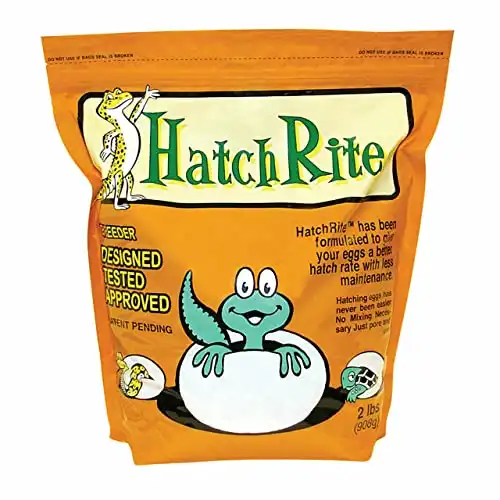
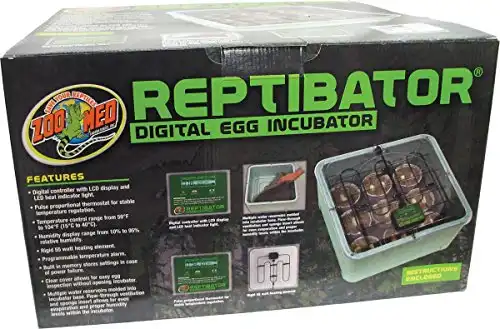
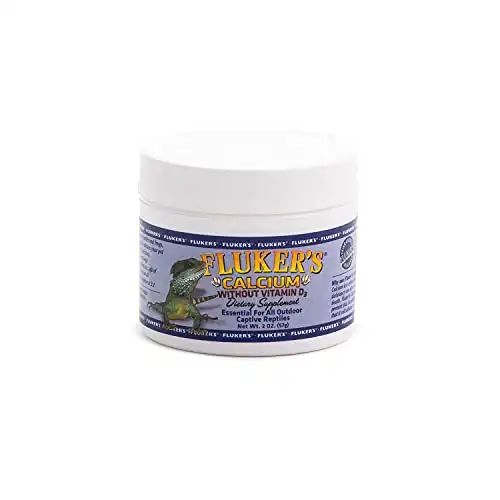
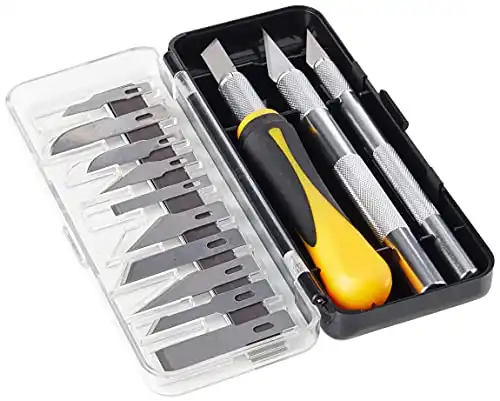
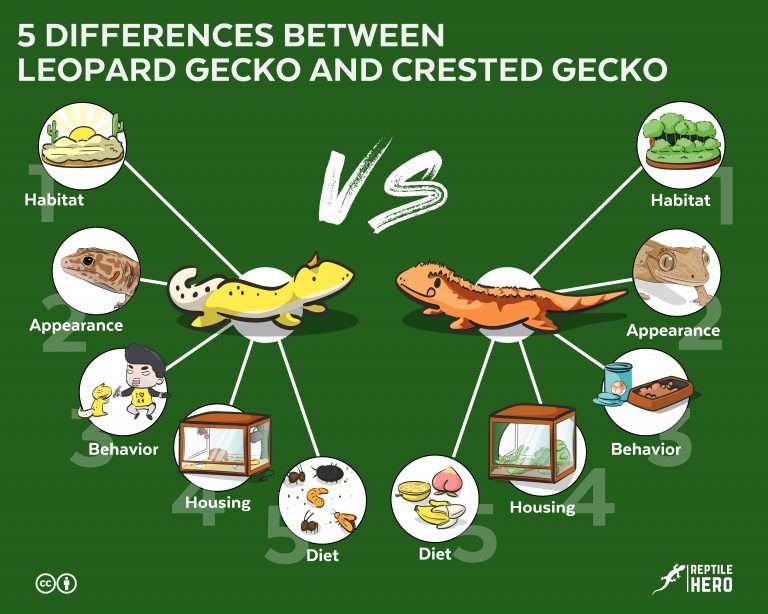
![Do Geckos Drink Milk? [Think it Twice]](https://www.reptilehero.com/wp-content/uploads/2021/07/Does-Gecko-Drink-Milk-Infographic-768x614.jpg)
![How to Choose a Halogen Lamp for Your Leopard Gecko [In-Depth]](https://www.reptilehero.com/wp-content/uploads/2021/07/word-image.jpg)

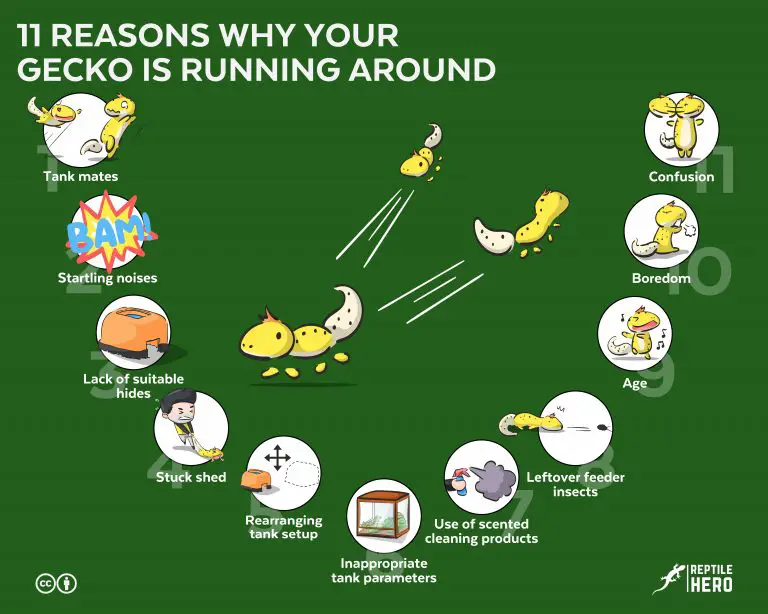
![Are Terrariums and Vivariums the Same? [6 Differences]](https://www.reptilehero.com/wp-content/uploads/2021/06/Terrarium-vs-Vivarium-768x614.jpg)